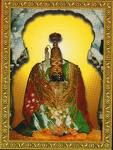|

|
About Tuljapur |
|
The temple
is situated on a very peculiar site. It is located on
one of the
deep slopes on the ranges of the Bala Ghat.
As one enters from the
gateway one has to descend nearly
some fifteen feet to reach the first stage of the
temple Prakara. This stage consists mainly of the large tank
known as the
Kallola tirth. |
The Legend and the Temple
After the construction of the Nivas of the devi was
over. Vishvakarma took leave of Brahma- deva on whose
command he had come down to the Yamunachala to build it.
Brahmadeva decided to create the-tirths necessary for
any kshetra. He then invited all the well-known and holy
waters on this earth to come to the Yamunachala.
The response to the invitation was immediate, and every
source of holy water that existed on the surface of the
earth and below it rushed to the spot. Ganga, Yamuna,
Sarasvati all obeyed the command. Various other tirths
from the Himalayas, Vindhyas, Sahyadris, Trikut and
Malay mountains flocked together.
There was a tumultuous assemblage of all these and on
account of the furor created by them Brahmadeva named it
‘Kallola tirth’. The power of the tirth is so great that
even its very darshan is capable of destroying sin. A
bath in the tirth is the first rite to be performed by a
pilgrim. The tank is walled off from all sides and
entrance into the enclosure is only on payment of a
fixed charge. Steps lead down to the water making it
easier to take a bath in it.
A dip in this tirth during the month of Magha is the
giver of great good. The Tulajarnahatmya states that
apart from sins, various diseases are cured by this
water. This tirth is a large rectangular reservoir forty
feet by twenty and is most probably a fourteenth century
construction. On one side of the tirth are a number of
aisles now used for residential purposes.
From the other side, that is, the northern side a flight
of steps leads down another fifteen feet taking the
visitor down to the second stage of the Prakara. This is
crowded with various tirths and some subsidiary shrines.
The point that attracts immediate attention is the 'Gomukh
tirth'. Here a stream of water is constantly falling
down some six feet from the Gomukh, a stone image of a
cow's head.
This flow of water comes from the Mankavati Tirth, as is
evident from the fact that when the latter dries up due
to scarcity of rains, the former also dries up. However,
the local tale is quite different. The water flowing
down from the Gomukh is Ganp herself. Once there came a
mendicant belonging to the Nath sampradaya. His name was
Garibanath. He was rather an unbelieving type of soul
and not paying any attention to the local elders decided
to go to the Ganges to enjoy real Ganga-snana.
When the Devi saw that her devotees had failed to
convince him she herself appeared before him and tried
to show him that this indeed was water from the Ganga.
But the man was in no mood to accept even the divine
explanations. He however, agreed in the end to carry
with him a stick and a lemon fruit to the Ganges and
drop them in the water there.
Walking down all the way to the Ganges, the Sadhu
performed all the rites at the Tirth, got the
satisfaction he longed for and then remembering the
Devi's words rather skeptically threw the stick and
lemon in the river, The man returned to Tuljapur in due
course and when, following the usual custom stood below
the Gomukh to bathe in the downpour, he saw the stick
and the lemon coming out of the Gomukh.
This at last convinced him that the water pouring forth
from the Gomukh was in fact Ganges water. The Mahatmyait
the Dharsa-tirth’, and says that it consists of the
three waters, that of Ganga, Yamuna and Sarasvati.
Along the same line are other Tirths. These are in the
nature of small tanks or wells and recently cupola-like
structures have been erected to cover them. Inscribed
plates indicate which tirth is what. A guardian or
Upadhyaya is sitting near each of these Tirths and
guides the visitor about the rites to be performed at
each.
There are the Ganeshtirth, the Amrit-kund, also known as
the Sudha kund. The whole assemblage of these tirths is
kept remarkably clean and tidy. Near them are small
shrines to some deities like Siddhi- vinayak, Vitthal,
Dattatreya etc.
Then to the east of the Gomukh tirth, but outside the
precincts of the temple courtyard is the Mankavati tirth
or the Vishnu tirth. This is a huge reservoir,
resembling a step well. The arched construction of the
aisles around it showing that it is a building of the
late Maratha period.
|